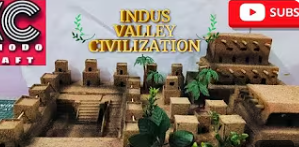Indus Valley Civilization 3d model – Komodo Craft

Creating a 3D model of the Indus Valley Civilization. The Indus Valley Civilization, also known as the Harappan Civilization, grow around 2500 BCE in what is now Pakistan and northwest India.
Recreating a 3D model of this civilization can be an educational experience that brings history to your life. This will walk you through the steps to make an well finished model of the Indus Valley Civilization.
Table of contents
Table of Contents
Materials Required
Assemble the required materials
- Cardboard: For making structures and city design.
- Clay: Helpful for making structures like houses, wells, and silos.
- Paint and brushes: Adding detail to your model.
- Glue and tape: For assembling various parts.
- Little stones, sand, and sticks: To make waterways, fields, and trees.
- Cutter : For exact cutting of materials.
- Ruler and compass: Making roundabout shapes.
- Chop sticks and straws
- PVA Glue / Fevicol
- Hot glue gun
- Old empty Box
- Wooden Dust
I have included a video below for better understanding
Steps to Building an Indus Valley Civilization 3D Model
Step 1: Research and Planning
Concentrate on the structure of Indus Valley urban areas, like Mohenjo-Daro and Harappa and a particular drainage system. collect images, maps to understand the city planning and features of the Indus Valley Civilization.
Step 2: Structure
Pick an appropriate scale for your model based on the size of your baseboard and available space. Utilize the city layout to separate your baseboard into segments addressing various parts of the city, like the citadel, lower town, granary area, and public baths.
Step 3: Prepare the Baseboard
Use a cardboard as the base of your model. Draw the city layout onto the board, marking where each structure should be placed.
Step 4: The Citadel and Lower Town
- Citadel: Use clay or cardboard to make structures like temples, administrative buildings, and the granary.
- Lower Town: Represent residential buildings using clay or small cardboard pieces, creating rectangular or square houses with flat roofs.
Step 6: Add Roads and Drainage system
The Indus Valley Civilization is known for its advanced road and drainage systems. Use strips of sandpaper or textured paper to represent roads, and add thin cardboard strips for drainage system.
Step 7: Add Natural Elements
Adding natural elements enhances your model.
- Fields and Farmland
- Trees and Plants
- River or Water Body
Step 8: Paint
Use earthy colors like brown, beige, and gray to paint buildings and roads, which reflects the natural materials used by the Indus Valley people. Paint the drainage system.
Tips for a Realistic Indus Valley 3D Model
- Accuracy : maintain distance between structures.
- Detailed Structures: Focus on adding features such as flat roofs, small windows.
- Material Texture: Use clay, sand, and paper to add texture,
- Research Photos : Use reference images to help you replicate real Indus Valley.
- Focus on Clean Finishing: A clean finish makes the model easier to understand.
Educational Benefits
Building a 3D model of the Indus Valley Civilization is not just a creative exercise—it also helps in understanding of ancient history and archaeology.
- Solar Cell Working Model – 1 Simple DIY Model for Students
- Area of Circle Working Model ✨
- Young’s double slit experiment Model
- Conic Section Working Model📐
- biosphere 3D model
Conclusion
Creating a 3D model of the Indus Valley Civilization is an engaging way to explore one of the most sophisticated ancient societies. By following the steps and tips in this guide. This project can serve as a educational purpose for school projects.
What materials are best for making an Indus Valley Civilization 3D model?
When creating a 3D model of the Indus Valley Civilization, selecting the right materials can greatly enhance the project. Commonly used materials include: clay, cardboard, and modeling foam for constructing buildings like the Great Bath and granaries. for more visit komodocraft.
How can I make the 3D model of the Indus Valley Civilization historically accurate?
To make your 3D model historically accurate, start with research.( Visit Komodocraft.com for full step by step making ) Study the architectural features of key structures, such as the grid-like city layout, drainage systems, and iconic landmarks like the Great Bath of Mohenjo-Daro. Use reference images. Highlight features like straight roads, the advanced drainage system.